From my earlier blog posts, you know that I have a workshop classroom where the notebook rules all. Like many of you, every piece of paper I give students is taped into notebooks and meticulously labeled. The notebooks hold the intricacies of the strenuous work of writing and the empathy of reading. Each student’s notebook is their own. In their notebooks, students can be their very best and sometimes even their worst. They can be an artist. They can be an author. They can be an editor. They can be themselves.
And they are.
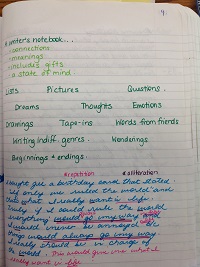
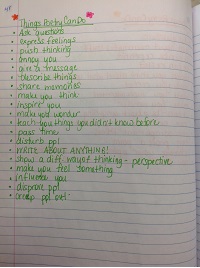
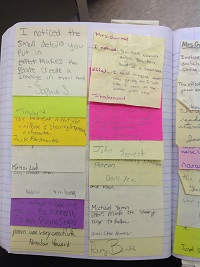
But now our whole world, our 8th grade Language Arts world, our writing community, has a new resident that we are not sure about. This new resident has brought a change to our community that affects our very being. In a time of change, my personal belief is that writing is an excellent release and the consistency of a notebook is a place of comfort. Yet, this visitor doesn’t consistently allow us this comfort. My school implemented a 1:1 iPad program in grades 6-8 around Thanksgiving.
There is a definite air of excitement regarding this new device. Students are cautious, yet fearless. Teachers are careful, yet innovative. On the one hand, I am a tech-person who hopes to teach kids new thought processes not just new apps; on the other hand, I love the act of handwriting and the thinking that comes with that physical work. But these new devices cause me to question: Is the world of handwritten notebooks relevant anymore? What is the best use of iPads for notebook work? And finally, what does a transformative digital language arts workshop classroom look like?
What is the answer?
Unfortunately, I don’t have a definitive answer for the use of iPads on a daily basis for Language Arts instruction, but I will share with you some ways I have used them and what has come of their use in my classroom.
The school release of iPads goes hand-in-hand with our opportunity to be a Google School that uses Google Apps for Education. I’ve been an advocate for the use of Google apps in the classroom for many years now, so it was an easy decision to jumpstart of iPad use in the classroom by diving into Google Apps and programs before moving to other tools. Each time I use technology with kids, I hope to increase their digital citizenship knowledge by introducing them to tools and ways of thinking that they can use outside of my classroom as well. Google Apps were a perfect place to start.
Tool: Google Classroom
 This tool is exclusively available for Google Education users and manages class lists and links to student’s Google Drive accounts.
This tool is exclusively available for Google Education users and manages class lists and links to student’s Google Drive accounts.
The advertised benefits:
- Sharing digital documents with a whole class that puts copies into students’ Drive folders.
- Class lists help the teacher manage students’ work submissions.
- Discussion threads allow interaction between classmates and teacher.
How I planned to use it: To distribute daily tape-ins (handouts that students tape into their writer’s notebooks).
What I think: I think this is a good tool to use for students to turn in summative projects. It’s not effective for sharing out materials with kids because it creates a very messy Drive for teacher and students. Classroom also fails to provide the opportunity to teach digital citizenship skills or online organization.
What students think: Currently, there is confusion between using Classroom to search for assignments and our district mandated Moodle pages. Students feel that it is a bit time consuming.
Tool: Google Drive
 This platform houses online documents that can be created, shared, and collaborated on.
This platform houses online documents that can be created, shared, and collaborated on.
The advertised benefits:
- Never lose a document again and have access to all documents that you may need at your fingertips.
- It also allows collaboration and unlimited sharing of documents.
How I planned to use it: After my experiences with Google Classroom, I transferred to sharing documents with kids via Drive. I taught them how to organize their Drive into folders and name documents.
What I think: This is a good platform to use to share documents with contacts. It is also relevant for teaching students how to organize digital work. However, if students want to write on a tape-in, like we have in our notebooks, they have to copy the text I share and create a new document. This allows them to edit the document.
What students think: Overall, they like the opportunity to have all their documents online. They are at a variety of places concerning this work. Some students are all online – using Drive for everyday work in Language Arts. Some students use tape-ins in notebooks and work online. Some are all hard copy notebooks. I allow students this variety and choice.
Tool: Evernote/Penultimate
 This program’s purpose is online organization and notebook creation. Penultimate is an Evernote sister app which syncs data but also allows handwritten notes.
This program’s purpose is online organization and notebook creation. Penultimate is an Evernote sister app which syncs data but also allows handwritten notes.
Advertised benefits:
- Consistently syncs and backs up data, has several Google tie-in programs and a stylus appears like actual handwriting.
How I planned to use it: We could create digital notebooks much the same as our paper copies.
What I think: While not transformative, this app has potential as a digital writer’s notebook, but the program is rudimentary. It needs additional features like cropping pictures and more precise writing (even with the joint Stylus).
What students think: They would rather use their notebooks.
To learn more about handwritten digital writers notebooks with Penultimate, read this blog post by Two Writing Teachers.
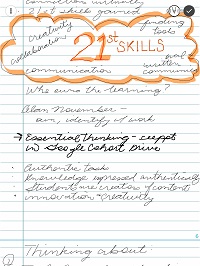
a writer’s notebook page in Penultimate
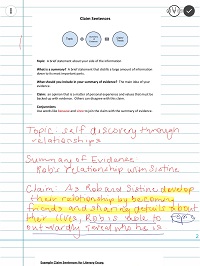
In the end, I am playing with the programs and listening to my students, but I don’t have a definitive answer. Rather, I have a question for you: What do you think of writer’s notebooks in a digital world? And how are you handling them in your classroom?
 Amy Gurney is an 8th grade Language Arts teacher for Bloomfield Hills School District. She was a facilitator for the release of the MAISA units of study. She has studied, researched, and practiced reading and writing workshop through Oakland Schools, The Teacher’s College, and action research projects. She earned a Bachelor of Science in Education at Central Michigan University and a Master’s in Educational Administration at Michigan State University.
Amy Gurney is an 8th grade Language Arts teacher for Bloomfield Hills School District. She was a facilitator for the release of the MAISA units of study. She has studied, researched, and practiced reading and writing workshop through Oakland Schools, The Teacher’s College, and action research projects. She earned a Bachelor of Science in Education at Central Michigan University and a Master’s in Educational Administration at Michigan State University.
 It’s a no-fail zone: the writing notebook. Notebooks anchor the daily work in my classroom and lead students to improve voice and clarity in their writing. Renowned author and literacy advocate Penny Kittle will lead us in exploring how to use quick writes, re-reading, and revision to motivate students to invest more in their writing. Breathe life into your writing workshop with notebooks for gathering, thinking, and finding important things to write about.
It’s a no-fail zone: the writing notebook. Notebooks anchor the daily work in my classroom and lead students to improve voice and clarity in their writing. Renowned author and literacy advocate Penny Kittle will lead us in exploring how to use quick writes, re-reading, and revision to motivate students to invest more in their writing. Breathe life into your writing workshop with notebooks for gathering, thinking, and finding important things to write about.  As a professional development coordinator for the Conway, New Hampshire, School District, Penny Kittle acts as a K-12 literacy coach and directs new teacher mentoring. In addition, she teaches writing at Conway’s Kennett High School and in the summer Literacy Institutes at the University of New Hampshire. Penny is the author of five books with Heinemann—Book Love: Developing Depth, Stamina, and Passion in Adolescent Readers (2013), Write Beside Them: Risk, Voice, and Clarity in High School Writing (2008) which won the 2009 James N. Britton Award from NCTE, Inside Writing (2005), coauthor (with Thomas Newkirk) of Children Want to Write (2013) and coauthor (with Donald H. Graves) of The Greatest Catch (2005) and Public Teaching(2003)—and she is a Heinemann Professional Development Provider.
As a professional development coordinator for the Conway, New Hampshire, School District, Penny Kittle acts as a K-12 literacy coach and directs new teacher mentoring. In addition, she teaches writing at Conway’s Kennett High School and in the summer Literacy Institutes at the University of New Hampshire. Penny is the author of five books with Heinemann—Book Love: Developing Depth, Stamina, and Passion in Adolescent Readers (2013), Write Beside Them: Risk, Voice, and Clarity in High School Writing (2008) which won the 2009 James N. Britton Award from NCTE, Inside Writing (2005), coauthor (with Thomas Newkirk) of Children Want to Write (2013) and coauthor (with Donald H. Graves) of The Greatest Catch (2005) and Public Teaching(2003)—and she is a Heinemann Professional Development Provider. 



 This tool is exclusively available for Google Education users and manages class lists and links to student’s Google Drive accounts.
This tool is exclusively available for Google Education users and manages class lists and links to student’s Google Drive accounts. This platform houses online documents that can be created, shared, and collaborated on.
This platform houses online documents that can be created, shared, and collaborated on. This program’s purpose is online organization and notebook creation. Penultimate is an Evernote sister app which syncs data but also allows handwritten notes.
This program’s purpose is online organization and notebook creation. Penultimate is an Evernote sister app which syncs data but also allows handwritten notes.

 Amy Gurney is an 8th grade Language Arts teacher for Bloomfield Hills School District. She was a facilitator for the release of the
Amy Gurney is an 8th grade Language Arts teacher for Bloomfield Hills School District. She was a facilitator for the release of the  The writer’s notebook is almost a sacred, mythical element of the writer’s workshop. It is where students’ writing lives take shape and are documented over the course of a year. In my classroom, the writer’s notebook held everything, and I mean EVERYTHING. Any paper I handed out was immediately taped or glued into the notebook, even if it had to be turned on its side or folded over two times. The writer’s notebook was our textbook. So when I heard each one of my students would be getting a Chromebook, I was excited about the possibilities and what that could mean for student writing. But what nagged at me was the loss of the traditional, tangible writer’s notebook.
The writer’s notebook is almost a sacred, mythical element of the writer’s workshop. It is where students’ writing lives take shape and are documented over the course of a year. In my classroom, the writer’s notebook held everything, and I mean EVERYTHING. Any paper I handed out was immediately taped or glued into the notebook, even if it had to be turned on its side or folded over two times. The writer’s notebook was our textbook. So when I heard each one of my students would be getting a Chromebook, I was excited about the possibilities and what that could mean for student writing. But what nagged at me was the loss of the traditional, tangible writer’s notebook.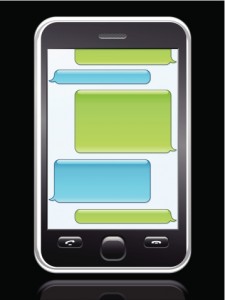 Instead of kids bringing their notebooks to one another and reluctantly allowing a partner to write on their prized draft, kids are sharing documents with one another and setting the editing level based on their comfort, with many choosing to only allow their partners to comment on a document. They no longer have to worry that someone is going to “mess up” their paper. They can simply focus on the comments, and especially relish hitting the “Resolve” button when they have revised something. I think it’s more than just reading the comments and making changes, though; kids are having conversations via their comments about writing as well as having conversations about their writing out loud. The conversations about writing are multilayered. If you’ve ever seen a teen text and talk to someone at the same time, you know that holding multiple conversations on various platforms is a way of life. And students also seem to be more responsive to my suggestions because my comments don’t physically change their writing; they are seen as just that: comments and suggestions.
Instead of kids bringing their notebooks to one another and reluctantly allowing a partner to write on their prized draft, kids are sharing documents with one another and setting the editing level based on their comfort, with many choosing to only allow their partners to comment on a document. They no longer have to worry that someone is going to “mess up” their paper. They can simply focus on the comments, and especially relish hitting the “Resolve” button when they have revised something. I think it’s more than just reading the comments and making changes, though; kids are having conversations via their comments about writing as well as having conversations about their writing out loud. The conversations about writing are multilayered. If you’ve ever seen a teen text and talk to someone at the same time, you know that holding multiple conversations on various platforms is a way of life. And students also seem to be more responsive to my suggestions because my comments don’t physically change their writing; they are seen as just that: comments and suggestions.  I had toyed with the idea of having students use a single, running Google Doc to keep a notebook, but that doesn’t work as easily as a traditional notebook does, especially when using Google Classroom, because some of the documents would be in Classroom and some would be in the running Google Doc. I thought toggling between the two would be difficult. Obviously, no single platform seems to be perfect (it’s unlikely that anything will ever meet every need/want). Despite the misgivings I may have, my students do not seem to be having the same internal struggles that I am having. Using their Chromebooks has quickly become second nature, with the biggest complaint being that the WiFi isn’t working quickly enough!
I had toyed with the idea of having students use a single, running Google Doc to keep a notebook, but that doesn’t work as easily as a traditional notebook does, especially when using Google Classroom, because some of the documents would be in Classroom and some would be in the running Google Doc. I thought toggling between the two would be difficult. Obviously, no single platform seems to be perfect (it’s unlikely that anything will ever meet every need/want). Despite the misgivings I may have, my students do not seem to be having the same internal struggles that I am having. Using their Chromebooks has quickly become second nature, with the biggest complaint being that the WiFi isn’t working quickly enough! ianna Taylor is an ELA and Title 1 teacher at Orchard Lake Middle School in West Bloomfield. She is a member of the AVID Site Team and Continuous School Improvement Team at her school, among other things. She is also a
ianna Taylor is an ELA and Title 1 teacher at Orchard Lake Middle School in West Bloomfield. She is a member of the AVID Site Team and Continuous School Improvement Team at her school, among other things. She is also a